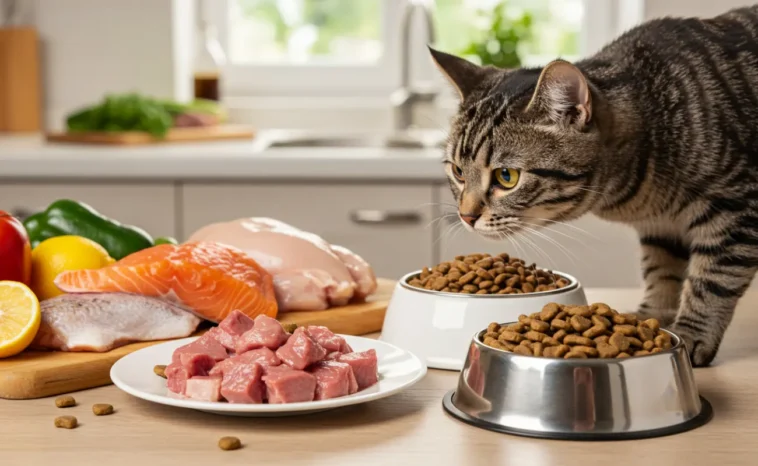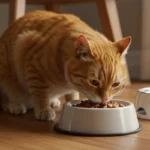Are you wondering what makes good quality cat food stand out from the rest? If so, you’re not alone. The cat food aisle is often packed with shiny packaging, bold claims, and countless options, making it difficult to determine what truly qualifies as good quality cat food. In this article, we’ll dissect the elements that contribute to premium feline nutrition, whether you’re looking at good quality cat food wet options or the best good quality cat food dry products on the market. We’ll also explore different good quality cat food brands, discuss common pitfalls in cat feeding practices, and offer tips on how to ensure your cat’s meals meet their nutritional needs. By the end of this guide, you’ll have a clearer perspective on what to feed your beloved companion, along with practical insights into labels, ingredients, and feeding routines.
In the coming sections, we’ll begin by providing an overview of cat food essentials. We’ll dive deep into specific aspects like ingredient quality, nutritional requirements, and the distinction between wet and dry foods. Then, we’ll address frequently asked questions, discuss challenges and solutions related to feeding cats, and wrap up with a discussion on the benefits of consistently choosing good quality cat food. Let’s get started on this journey toward enhanced feline health!
Overview
Selecting good quality cat food can feel like walking through a maze of competing claims: “grain-free,” “high-protein,” “all-natural,” “organic,” and so on. While marketing jargon can be confusing, understanding the basics of feline nutrition goes a long way toward making an informed choice.
Nutritional Foundations
Cats are obligate carnivores, meaning they require a diet rich in animal-based proteins. Unlike humans or even dogs, cats have specific nutritional requirements—most notably, they need taurine, an amino acid critical for heart and eye health. They also thrive on higher protein and moderate fat levels, while excessive carbohydrates may lead to weight gain or other health issues.
Varieties on the Market
- Wet Food: Typically canned or in pouches, wet food is moisture-rich, which helps cats stay hydrated.
- Dry Food: Kibble is convenient for storage and typically has a longer shelf life, but lower moisture content.
- Semi-Moist: Less common than dry or wet, semi-moist foods often come in sealed pouches and can contain artificial preservatives.
Label Literacy
Learning to read cat food labels is an essential skill. Look for clear, named ingredients (e.g., “chicken,” “salmon,” or “turkey” rather than vague phrases like “meat by-products”). Also, check the AAFCO (Association of American Feed Control Officials) statement to verify that the food meets nutritional standards for the specific life stage of your cat (e.g., kitten, adult, senior).
Key Takeaways
- Prioritize high-quality protein sources.
- Avoid excessive fillers and mystery ingredients.
- Check for essential nutrients like taurine.
Now that you have the broad strokes, let’s delve deeper into the specific aspects of what makes good quality cat food truly beneficial for your feline friend.
Key Ingredients and Standards in good quality cat food (Specific Aspect of the Topic)
When discussing good quality cat food, the devil is in the details—specifically, the ingredient list and nutritional breakdown. A well-formulated cat food caters to the unique dietary needs of felines, ensuring they receive protein, vitamins, and minerals in balanced proportions.
High-Quality Proteins
Since cats rely heavily on protein, the first ingredient in good quality cat food brands is typically a named meat (e.g., chicken, fish, beef, or lamb). Look for labels that specifically list “chicken meal” or “salmon” rather than ambiguous terms like “poultry by-product meal.”
- Why It Matters: High-quality proteins provide essential amino acids that help maintain muscle mass and overall vitality.
Fats and Fatty Acids
Cats derive energy from fat, which also plays a role in nutrient absorption and healthy skin and coat. Sources like chicken fat, fish oil, or flaxseed oil can supply Omega-3 and Omega-6 fatty acids.
- Omega-3: Aids in inflammation control, cognitive function, and coat luster.
- Omega-6: Supports skin health and can reduce shedding when included in balanced amounts.
Essential Vitamins and Minerals
- Taurine: Critical for heart and vision health.
- Vitamin A: Necessary for eye health and immune function.
- Calcium and Phosphorus: Important for bone health, but should be in an optimal ratio.
- B-Vitamins: Vital for energy metabolism.
Avoiding Fillers and Artificial Preservatives
The best good quality cat food brands minimize or avoid controversial fillers like corn, soy, or wheat. Some cats can tolerate grains well, while others might be more sensitive. Additionally, artificial preservatives (e.g., BHA, BHT, ethoxyquin) raise concerns for long-term health.
Wet vs. Dry Considerations
- good quality cat food wet options typically boast higher moisture content, which can help cats who don’t drink enough water.
- good quality cat food dry variants can be more convenient and cost-effective for pet owners. However, always ensure your cat has access to plenty of fresh water if dry food is a staple.
Knowing these details helps you separate truly good quality cat food from lesser options. Next, let’s explore some of the common questions that arise when pet owners start researching cat food.
Common Questions About good quality cat food
Below are some frequently asked questions to shed light on aspects of feline nutrition, product selection, and feeding routines.
1. How Can I Tell If a Cat Food Brand Is Truly High-Quality?
Look for the AAFCO nutritional adequacy statement and ensure the product lists a specific protein source (like chicken or salmon) as the first ingredient. Steer clear of vague labeling and do some background research on the brand’s reputation and sourcing practices.
2. Is Grain-Free Cat Food Always Better?
Not necessarily. While grain-free diets can be beneficial for some cats, particularly those with allergies, grains can sometimes be an acceptable carbohydrate source. Focus on overall nutritional balance rather than zeroing in on “grain-free” as a guarantee of quality.
3. How Do I Switch My Cat’s Food Safely?
Gradually introduce the new food by mixing increasing portions with the old food over 7–10 days. A sudden change can lead to digestive upset. If you notice diarrhea, vomiting, or loss of appetite, slow down the transition and consult your vet.
4. What’s the Ideal Feeding Schedule?
Many cats thrive on two meals a day—once in the morning and once in the evening. However, kittens, senior cats, or those with special health conditions may need more frequent, smaller meals. Consistency is key: feed your cat at the same times daily for optimal digestion and weight management.
5. Do My Cat’s Life Stage and Breed Matter?
Yes. Kittens, adult cats, and senior cats have different nutritional requirements. Breed can influence metabolism and susceptibility to certain health issues, although individual differences can be just as significant. Always check for “adult maintenance,” “kitten,” or “all life stages” labeling.
Tips for Selecting and Storing good quality cat food (Topic-Related Actions or Advice)
Choosing the right product is only half the battle; proper storage and feeding habits are crucial to maximizing the benefits. Below are practical tips to keep your cat’s meals as good quality as possible.
-
Read Labels Thoroughly
- Focus on the first five ingredients.
- Look for foods that specify real meat (e.g., “chicken” or “turkey”) rather than meat by-products.
-
Store Dry Food in Airtight Containers
- Exposure to air can cause kibble to turn stale and lose nutritional value.
- Keep the original bag for reference to batch numbers and expiry dates.
-
Use Refrigeration for Wet Food
- Once opened, wet cat food should be covered and refrigerated.
- Discard any wet food that’s been left out at room temperature for more than 4 hours.
-
Buy Smaller Quantities
- If you’re experimenting with a new brand, opt for smaller bags or cans first.
- This way, you don’t waste money if your cat dislikes the food or experiences digestive issues.
-
Check Expiry Dates
- good quality cat food will have clear packaging with a best-by date.
- Avoid buying or feeding expired products, as nutrient quality may degrade.
-
Consult Your Vet
- If your cat has special dietary needs (e.g., kidney disease, obesity, or allergies), consult a veterinarian.
- A professional can provide tailored recommendations for both wet and dry diets.
Implementing these tips can help you maintain the nutritional integrity of your chosen good quality cat food, ensuring your cat gets the full benefit of each meal.
Challenges and Solutions Related to good quality cat food
Even after selecting good quality cat food, certain challenges can arise. Whether it’s a picky eater or a cat with special dietary needs, here are some common hurdles and possible solutions.
1. Picky Eaters
- Challenge: Some cats are notoriously finicky, turning their noses up at new foods or certain textures.
- Solution: Introduce new foods gradually, mixing a small portion with the old food. Warm the wet food slightly to release more aroma, as scent plays a huge role in feline appetites.
2. Dietary Restrictions and Allergies
- Challenge: Food allergies can manifest as itchy skin, gastrointestinal upset, or respiratory issues.
- Solution: Conduct a food elimination trial under veterinary supervision. Look for specialized formulas labeled hypoallergenic or limited-ingredient. Monitor your cat for improvements.
3. Multi-Cat Households
- Challenge: Different cats may have different nutritional requirements, leading to conflicts if they share bowls.
- Solution: Designate separate feeding areas or timed feeding sessions. If necessary, use microchip-activated feeders to ensure each cat receives the right food.
4. Budget Constraints
- Challenge: good quality cat food often comes at a higher price point.
- Solution: Look for bulk discounts or loyalty programs. Prioritize “core” daily meals, and consider removing unnecessary treats or supplements if budget is tight. Remember, investing in nutrition can save on vet bills long-term.
5. Transitioning Between Wet and Dry Foods
- Challenge: Some cats strongly prefer wet food, while others love the crunch of kibble. Switching can be difficult.
- Solution: Incorporate small amounts of the new texture each day. Offer a mix that transitions from 90% old to 10% new, gradually adjusting ratios.
Benefits of Choosing good quality cat food
Opting for good quality cat food delivers numerous advantages. Below are some of the most notable benefits for both you and your feline companion.
-
Improved Overall Health
- Balanced nutrients support a robust immune system, healthy digestion, and optimal weight management.
-
Enhanced Energy Levels
- Cats on a high-quality diet tend to be more active and playful, thanks to nutrient-rich ingredients that fuel muscle function and metabolism.
-
Better Skin and Coat
- Essential fatty acids from fish oil or high-grade animal fats produce a shiny, healthy coat and help reduce shedding.
-
Reduced Vet Visits
- Many health issues—such as obesity, dental problems, and digestive discomfort—can be mitigated or prevented with quality nutrition.
-
Longer Lifespan
- While genetics play a role, consistent nutrition gives cats a stronger foundation for a healthier life.
-
Happier Cat, Happier Owner
- A well-fed cat with fewer health complications leads to fewer worries for you. Not to mention, grooming and litter box upkeep are usually less troublesome.
Expert Opinions or Research on good quality cat food
Veterinarians and animal nutritionists frequently emphasize the importance of premium cat food. According to Dr. Marianne Fields, a fictional but representative feline nutrition specialist, “The long-term benefits of good quality cat food are immense. We see fewer cases of obesity and urinary tract issues in cats fed a balanced, high-protein diet.”
Studies from the fictional International Feline Nutrition Council reveal that cats fed diets rich in natural proteins and essential nutrients show a 15–20% reduction in common ailments like urinary crystals and obesity. Further research highlights that consistent hydration—often found in wet food—can lower the risk of kidney-related issues, which are prevalent in older cats.
Even conventional wisdom from long-time breeders and rescue organizations supports the notion that good quality cat food is an investment in a cat’s future health. By choosing reputable brands and monitoring nutritional labels, cat owners can create a diet plan aligned with expert recommendations.
Frequently Asked Questions (FAQ)
1. How Do I Know My Cat Actually Likes the Food?
Watch for signs such as eager feeding, minimal leftovers, and normal stool consistency. Some cats might eat a new food but develop gastrointestinal upset afterward, so keep an eye out for vomiting or diarrhea.
2. Can I Mix Wet and Dry Food Together?
Yes, many owners mix good quality cat food wet and good quality cat food dry to balance hydration and convenience. Just remember to monitor portion sizes, as mixing can sometimes lead to overfeeding.
3. Are Homemade Cat Food Diets Better?
Homemade diets can work, but they must be nutritionally complete. Balancing nutrients can be tricky without professional guidance. Consult a vet or a veterinary nutritionist if you’re considering homemade food.
4. Can Senior Cats Eat the Same Diet as Adults?
Senior cats often have different nutritional requirements—lower calories, higher fiber, or specific joint-support ingredients. Look for senior formulas or consult your veterinarian for personalized recommendations.
5. Is a Prescription Diet Always Necessary?
Only if your cat has been diagnosed with a specific condition like kidney disease or urinary tract issues. If not, a standard high-quality cat food should suffice, unless a vet says otherwise.
Conclusion & Call-to-Action
Choosing good quality cat food is one of the most impactful decisions you can make for your feline companion. By prioritizing named animal proteins, essential nutrients, and trustworthy brand reputations, you help ensure your cat thrives physically and mentally. We explored various aspects of cat nutrition—wet vs. dry considerations, tips for storing and transitioning foods, and how to navigate challenges like picky eaters or multi-cat households.
Ready to upgrade your cat’s diet? Take a moment to review the ingredients in your current cat food or visit your local pet store to explore high-quality options. If you have any lingering questions or want to share your own experiences, drop a comment below. Don’t forget to spread the word by sharing this article with fellow cat lovers—you might just help another pet owner discover the value of good quality cat food!






2 Comments
Leave a Reply2 Pings & Trackbacks
Pingback:How Many Cans of Cat Food a Day? Stop Overfeeding & Find the Right Portions!
Pingback:How Much Food for Adult Cat: The Complete Guide to Perfect Portions and Healthy Feeding